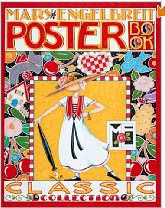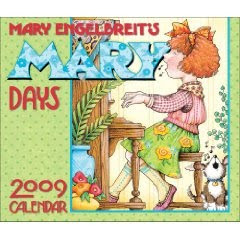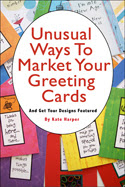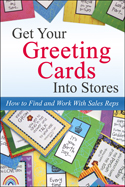
-->
I recently discovered the book Mary Engelbreit: The Art And The Artist, that was first published in 1996. It is about her path into art licensing and greeting card design. She is now a successful licensor, her career spans over decades, and she was awarded "best art license of the year" by LIMA.
Mary's book is one of the more encouraging and practical books I've read in awhile. She confirmed my inherent belief that if someone tries to impose rules and prerequisites on entering this career, someone else will come along, break all the rules, and become successful. Here are some things I learned from reading her book:
1. Don't believe everything you hear.
While I'd seen her cards over the years and admired her work, after reading her book I realized I had been completely misinformed about her personal journey. I'd heard that she first got into greeting card design because she had extensive financial resources to experiment with. Boy was that wrong! In fact, it was quite the opposite.
In fact, it was quite the opposite.
While I'd seen her cards over the years and admired her work, after reading her book I realized I had been completely misinformed about her personal journey. I'd heard that she first got into greeting card design because she had extensive financial resources to experiment with. Boy was that wrong!
 In fact, it was quite the opposite.
In fact, it was quite the opposite.
2. Rock stars are people too.
Mary did not have resources for college, she didn't attend art school, and her husband worked as a social worker, all the while she struggled with the financial risks of trying to be an artist. In a lot of ways, she was no different than most people. She couldn't take expensive business risks. She doubted herself. She was even discouraged from being an artist by high school teachers. And she did not have thousands of dollars to lay down for a print run, just to see if something would sell.
Mary did not have resources for college, she didn't attend art school, and her husband worked as a social worker, all the while she struggled with the financial risks of trying to be an artist. In a lot of ways, she was no different than most people. She couldn't take expensive business risks. She doubted herself. She was even discouraged from being an artist by high school teachers. And she did not have thousands of dollars to lay down for a print run, just to see if something would sell.
3. Create your own show
Some stories she shared were painful, like when she bought a booth at the New York Stationery show and only had 12 cards to display. She was mortified to see all the other vendors, who had hundreds of cards. She also toted her portfolio all around New York only to be rejected by everyone she met. Other stories were heartwarming, like the day she felt sad because couldn't go to art school and have a "real" art show, so she decided on a whim to just to make her own art show happen at her job, in a retail store. All her work sold out.
 4. Forgive yourself for mistakes
4. Forgive yourself for mistakes
 4. Forgive yourself for mistakes
4. Forgive yourself for mistakes
She had many hard knocks. She got into a bad business partnership, lost some of her art, and had emotional challenges of deciding whether being an artist was realistic.
5. You don't need to go to art school.
It was amazing for me to learn that she doesn't know how to paint, and she learned to draw simply by recopying old children's books and using colored pencils and markers. Later she developed her own imaginary characters. This made me wonder if the reason she became one of the top illustrators in the country, is because she "didn't" go to art school.
 6. Draw what you like, not what you think will sell.
6. Draw what you like, not what you think will sell.
 6. Draw what you like, not what you think will sell.
6. Draw what you like, not what you think will sell.
She emphasized how incredibly important it is for her to draw things she likes. Only later will she think about adapting the drawing to a product. She said if she instead tried to develop a design based around a product as the starting point, it was always a failure. Instead, she decided to hire other people to adapt her drawings to products, and she focused on drawing what she really loved, often things in her daily life.
 7. Make new rules.
7. Make new rules.
 7. Make new rules.
7. Make new rules.
She breaks rules I'd come to accept as gospel from the licensing world. In fact, what I learned is that while it's important to trust your heart, you also need to trust your own intelligence. There are people who may try to impose their own rules on you about the "way things are" in the market place, with stores, with agents, with manufacturers, with your credentials, with demands, etc. But Mary made her own rules, not out of protest, but out of a gentle kindness towards herself.
~
Greeting Card Business ebooks.
You can support this blog by ordering Kate's eBooks starting at only .99 cents!
They can be read on your kindle, ipad, ipod, cellphone, or your computer.
Unusual Ways to Market Your Greeting Cards and 22 Places to Get Your Designs Featured A booklet on how to get your cards noticed in non-traditional ways. Everything from why you should send cards to your dentist, to how to get special features in national publications. Great tips for designers who are starting out and want to get their cards into the hands of people beyond friends and family. Special Section: Submissions guidelines and contacts for 22 Gift Industry publications and professional gift industry blogs that seek out new greeting card designs to feature for free.
7 Mistakes Greeting Card Writers Make Booklet on common mistakes greeting card writers make and what to avoid when submitting greeting card verse to publishers. Today, greeting card publishers are shying away from traditional stereotypes, and may even include pets as family members. This article talks about how to create a trendy card that reflects the contemporary world we live in, and how to use our own personal experiences to create great card verse. Topics include: how to avoid limiting the market of who could buy your card, when to use adjectives, how not to creating card for enemies, how to write like people talk and a list of why card sentiment submissions are often rejected. The good news is you can increase your odds of success by 60% by doing a few simple things.
20 Steps to Art Licensing: How to Sell Your Designs to Card and Gift Companies A booklet on how to license your art to companies that publish greeting cards, and manufacture coffee mugs, magnets, wall hangings, kitchen items, and dozens of other gift items. This booklet covers 20 basic steps from how to prepare your art, to what companies to contact. It includes topics on: How to find agents, classes and what trade shows to attend. There are extensive resources on social media, licensing community groups, copyrights, and lists of interviews with professional designers.
Get Your Greeting Cards Into Stores: How to Find and Work With Sales Reps If you already make your own greeting cards, this book explains how to get your cards into stores and sell them sell nationwide. Included are guidelines on: how to price your cards for a profit, how to get professional feedback, where to find a sales representative and and what industry standards you should follow. All the information is also applicable to gift items, such as magnets, journals, calendars, collectibles, etc. Chapter topics: Getting Professional Feedback, Getting Your First Account, Pricing and Profits, Sales Reps 101, Where to Find Reps, Rep Readiness Checklist, Pitching Your Line to a Rep and Working With Reps.
Greeting Card Class
You can also sign up for the class called Getting into the Greeting Card Business. The content is based on my experience of working in the industry for over 20 years, and from publishing over 1,000 cards.
Register here.
~





2 comments:
Thank you for posting this. I had no idea. This is very inspiring. I had no idea this was her journey.
Love this book and have a millionty sticky notes in mine...Mary offers great pragmatic and creative inspiration.
Love where she says something to the effect, "Good timing is overrated!"
As always ... great post!
Post a Comment